Samsung has been playing in the consumer SSD space longer than most people know. It was their early SSDs that graced the likes of Sony ultraportable notebooks and found their way in other high-end premium builds from many other brands. But not until recently have consumers been able to trot out to the store to pick up a Samsung-branded SSD. In late August Samsung quietly started selling the 470 Series SSD in retail, including capacities of 64GB (MZ5PA064HMCD-0AA00), 128GB (MZ5PA128HMCD-0AA00) and 256GB (MZ5PA256HMDR-0AA00).
Samsung quotes 250MB/s read times across the line and 220MB/s write speeds for the 256GB (which also plays into the 470 Series name) and 128GB capacities and 170MB/s write for the 64GB. Perhaps more impressive though are the power numbers, Samsung quotes 0.24W for active use and 0.14W during idle. While our tests are more intensive and yield higher than quoted power numbers, these are some of the lowest we’ve ever seen presented.
While we’ll dive into it more in the review, it’s also worth noting off the top that the 470 series has gorgeous design and the retail packaging has clearly been influenced by Apple’s elegant, yet minimalist, footprint. We don’t talk about drives being pretty and well packaged very often, this may even be a first, obviously we were impressed enough to find the point worth mentioning. In the end it’s all about performance and reliability, but hey, if you can look good at the same time, then all the better.
Samsung 470 Series SSD Specs
- 256GB, 128GB and 64GB capacities
- 256GB – 238.47GB formatted capacity
- SATA 3Gb/s interface
- 2.5″ form factor
- Samsung controller model S3C29MAX01-Y340
- Power consumption – Active – 0.24W, Idle – .14W
- Operating temperature 0°C to 70°C
- MTBF : 1,500,000 Hours
- Warranty – 3 years
Aesthetics
If you follow Samsung much as a global brand, you’ll know style is a big focus, whether it’s their Touch of Color HDTV designs or in this case, a stylish SSD. While we often don’t see SSDs in their retail packaging, when they come in for testing they’re normally in a mundane brown box. The Samsung on the other hand was looking to make an impression; packaged Apple-style in a clear acrylic case with the faux brushed-aluminum case front and center.

The SSD is highlighted by an orange accent which displays the drive’s capacity. The look is quite modern and while 99% of the time it won’t matter once the drive is buried within a system, if you happen to have a computer case where you can see the drives, and you want one that looks good, the 470 Series is tough to beat.

The top half of the case is made of plastic with the brushed metal cover glued to the top. The bottom is alloy, which adds strength to the design and gives the circuit board inside a strong footing. From the outside there are no exposed screws, making for a very clean appearance. Build quality is pretty decent, even with the case being primarily plastic. The drive felt solid when gripping it and didn’t feel flexible in the slightest. Generally speaking though, you won’t really notice even the weakest design once the drive is installed in your system.
Disassembly
As we mentioned in the aesthetics section the Samsung SSD 470 has no externally visible screws or clips. To open the case—after taking pictures of course—we used the tried and true method of a pry bar and sledge hammer. Actually, the drive just needed a fingernail slid around the perimeter to release the plastic retention clips that held the top cover in place. Once that was off it was simple to get at the rest of the drive.
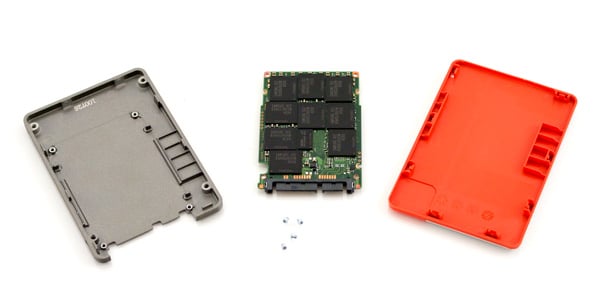
Once inside the case, the small PCB is held to the bottom cover of the drive with four small Torx screws. Interestingly, the PCB is much smaller than the 2.5″ case that houses it. It’s likely that Samsung uses this same PCB for their 1.8″ SSDs, albeit with a different connector.
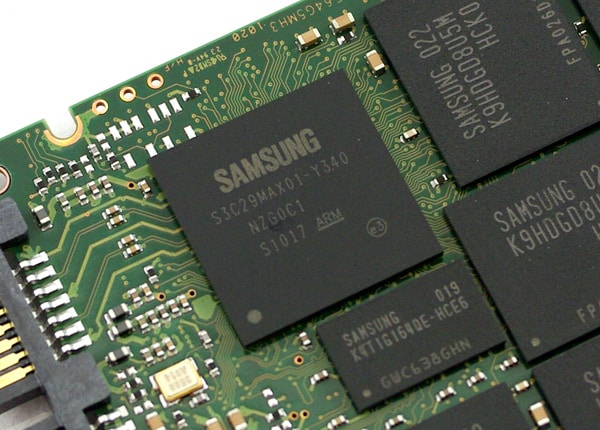
The PCB layout is very efficient and pretty much packed as tight as physically possible. On first glance we kind of scratched our heads trying to figure out which big chip was the controller, with everything the same height, printed with the same font, and all but the RAM just about the same footprint. Looking a bit harder we found it on the back side.
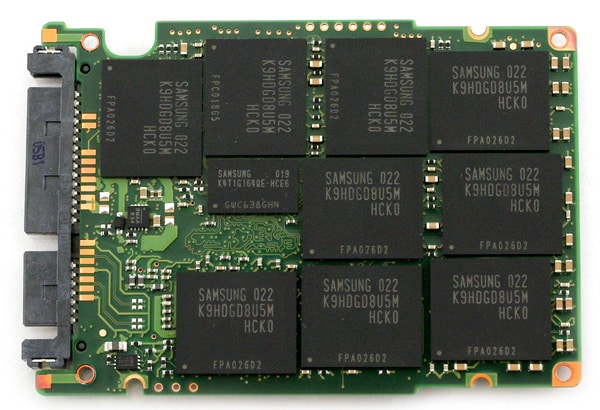
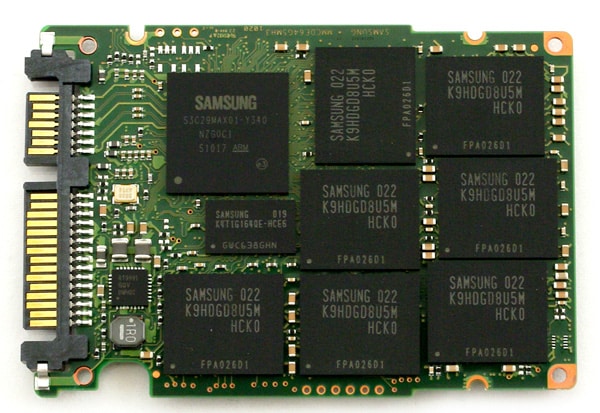
The controller (as well as every other component inside the SSD) is made by Samsung. Its has the markings S3C29MAX01-Y340, with ARM underlined towards the bottom. The board also includes two 128MB (256MB total) K4T1G164QE Samsung DDR2-667 modules, one located on each side of the PCB. The large storage capacity comes from 16 Samsung K9HDGD8U5M 16GB modules. Overall a very nice internal design that doesn’t leave much room for waste.
Synthetic Benchmarks
The Samsung 470 Series SSD enters the market at a particularly competitive time, where the Intel X25-M and SandForce SF-1200 equipped SSDs currently reign supreme. The 470 Series actually gets its name from its speed, with 470 being the sum of the 256GB’s sequential read and write speed being 250MB/s and 220MB/s write. The real test though is how drives perform outside of just sequential performance though.
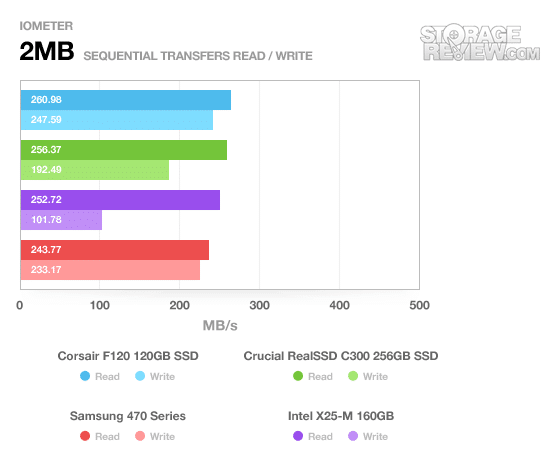
Our first benchmark is our 2MB IOMeter sequential file transfer test. This is helpful to see how the manufacturer’s claims stack up and see how fast the drive is in the best possible scenario. We measured an average read speed of 243MB/s and a write speed of 233MB/s. While the read speed was a bit under what Samsung had quoted, the write speed made up for it. So instead of the 470 Series maybe we should call it the 473.
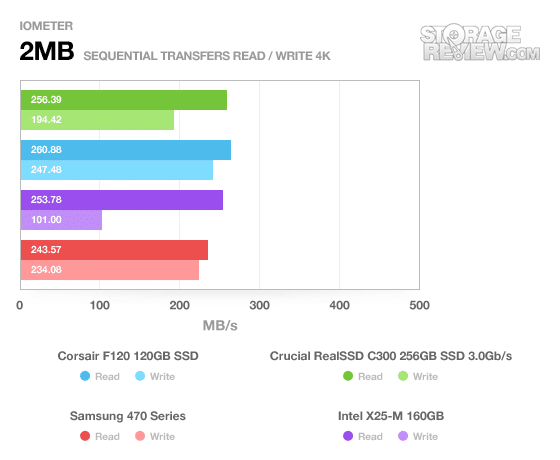
With 4K-alignment the read speed dropped ever so slightly and the write speed went up a bit.
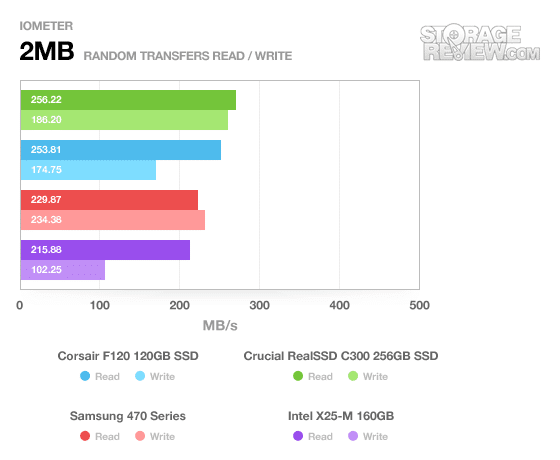
In our 2MB random transfer test the Samsung scored 229MB/s read and 234MB/s write. This puts it right above the Intel X25-M, not to mention more than doubling the write speed.
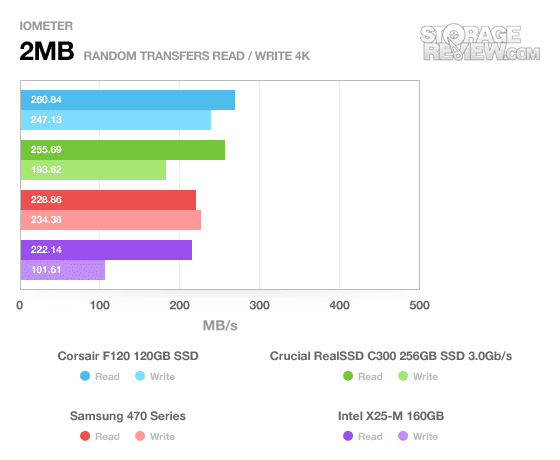
With 4K-alignment we saw the read speed drop slightly, with the write speed staying identical.
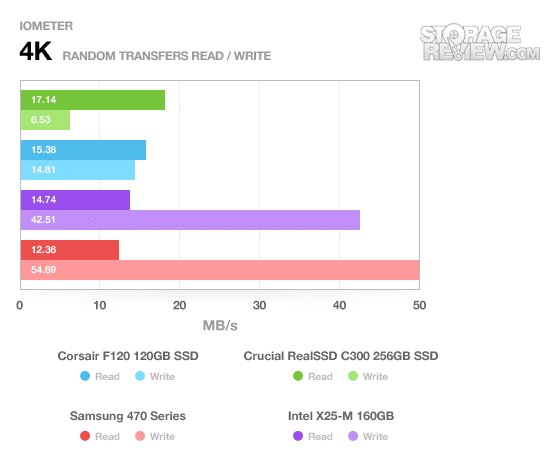
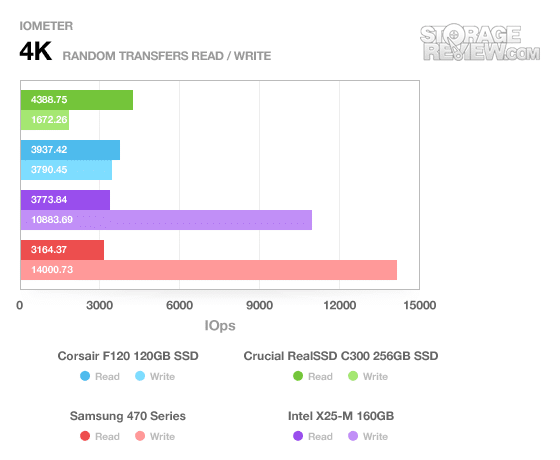
We found some pretty interesting results with our IOMeter 4K random transfer test. In the past, the only drive to really do exceptionally well in this test has been the Intel X25-M, scoring very well with un-aligned 4K transfers. No more though… the Samsung SSD 470 blew it away, having an exceptional 54.69MB/s write speed, with a read speed of 12.36MB/s.
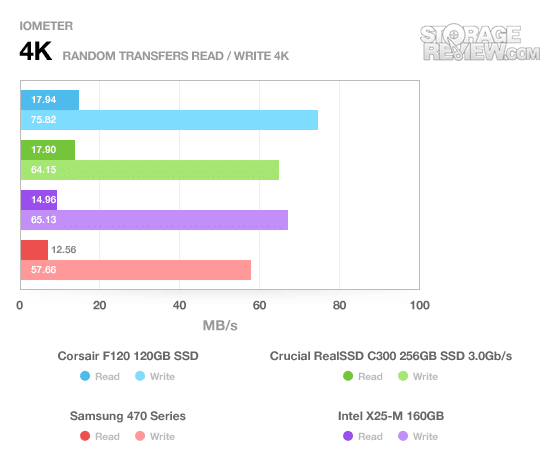
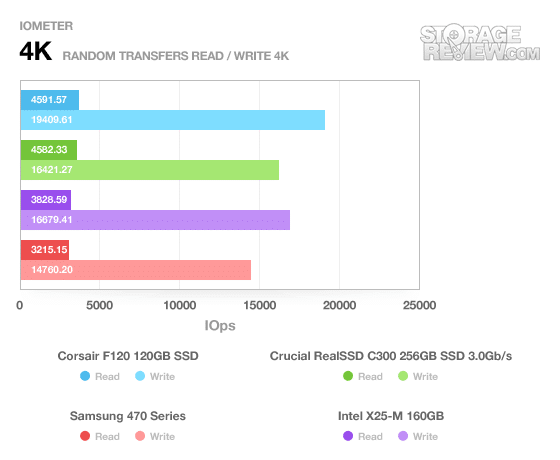
With 4K-alignment the write speed went up to 57.66MB/s and the read speed increased 0.20MB/s, but this time around the other SSDs surpassed the Samsung model.
As we saw in the previous 4K random transfer test, the Samsung SSD 470 excels in unaligned 4K transfers… actually beating out the Intel in its stronghold. We measured an average latency of 0.071ms.
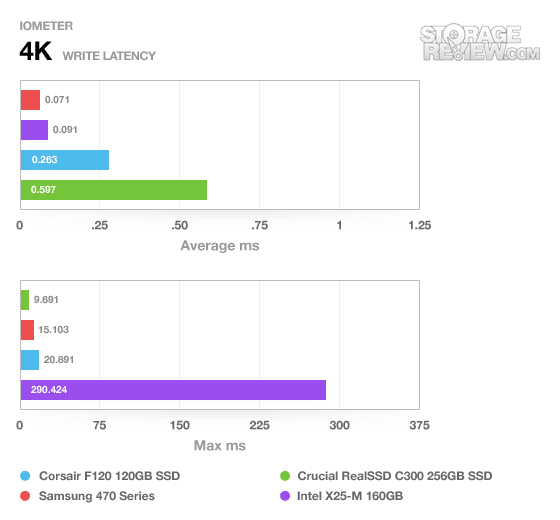
With 4K-alignment the Samsung SSD 470 stays just about as quick, but the Intel X25-M and SandForce-based Corsair F120 surpass it. Still managed a very respectable 0.067ms of lag.
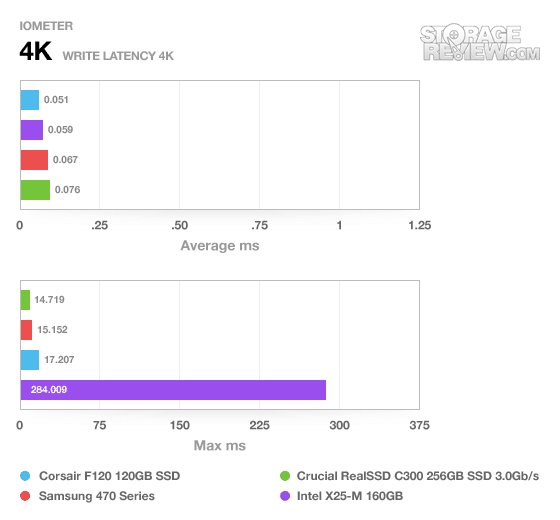
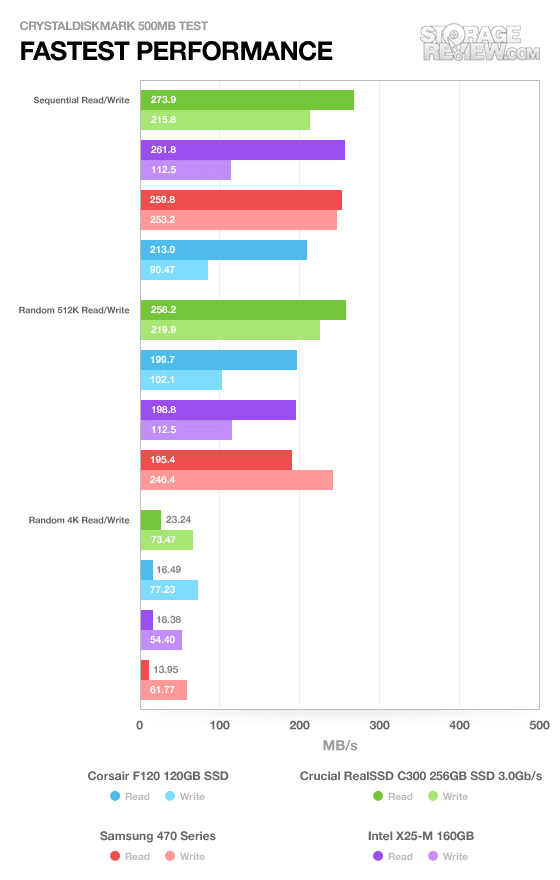
CrystalDiskMark showed more favorable results for the Samsung SSD 460, with a sequential read speed of 260MB/s and a write speed of 253MB/s. The 4K random transfer tests stayed pretty close to what we found using IOMeter.
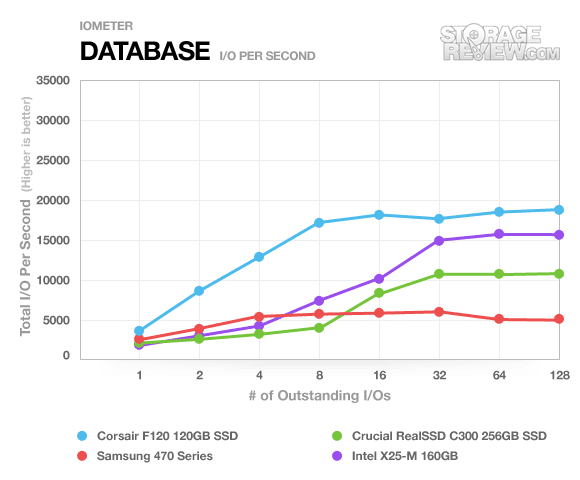
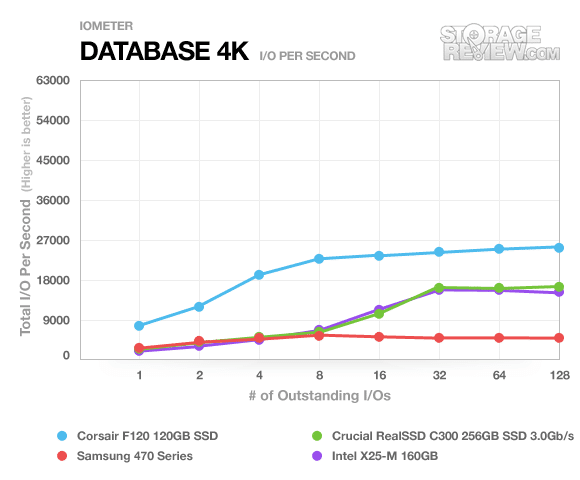
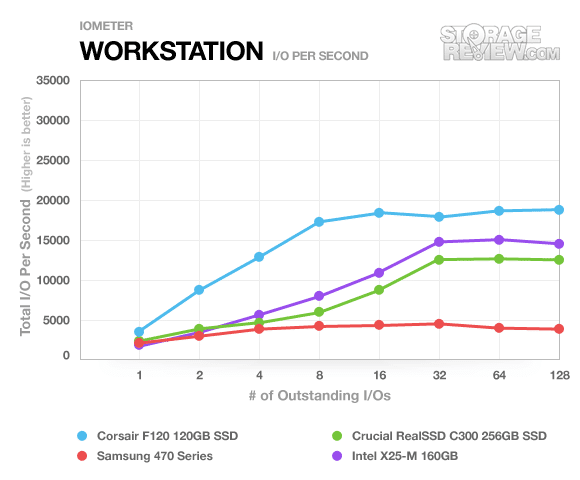
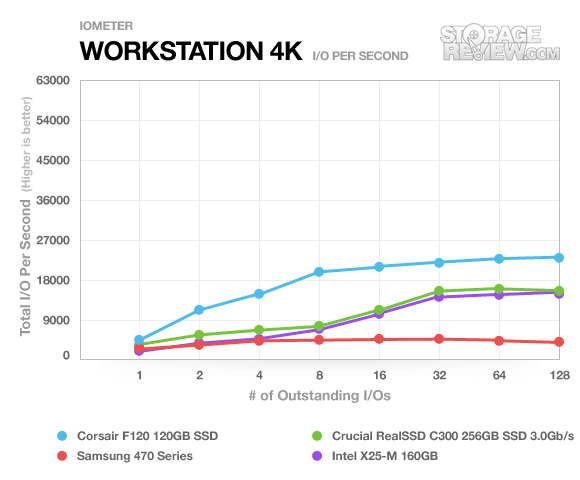
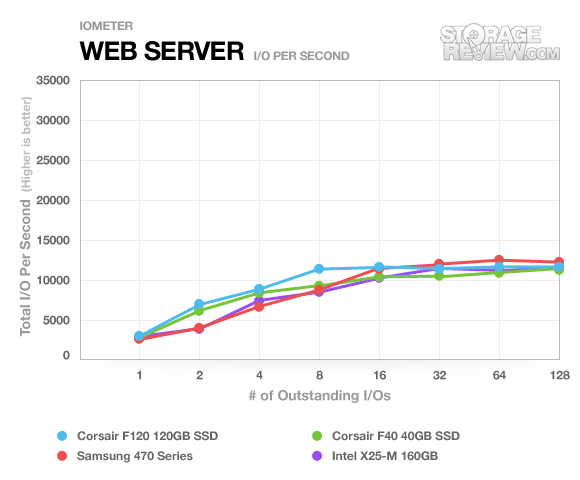
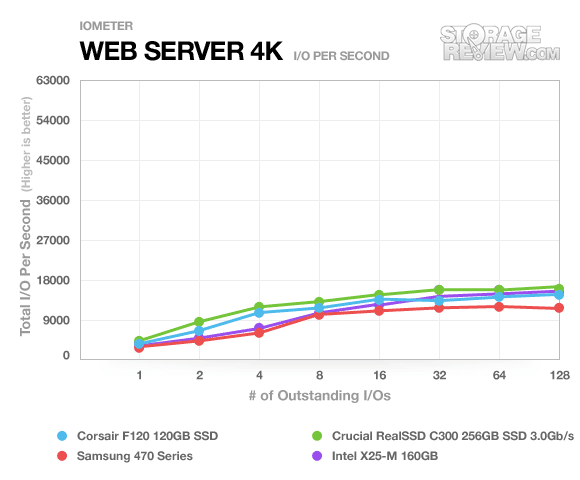
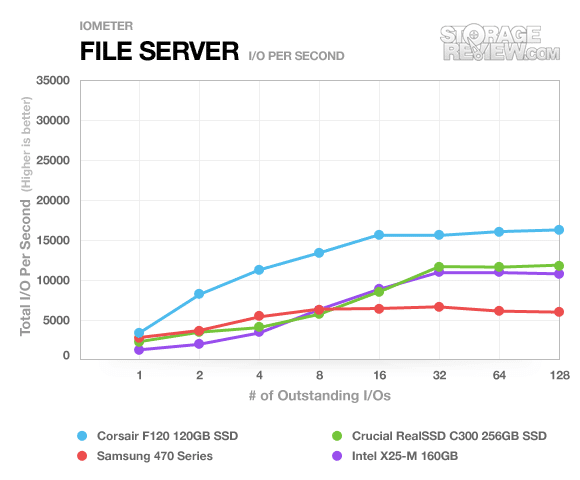
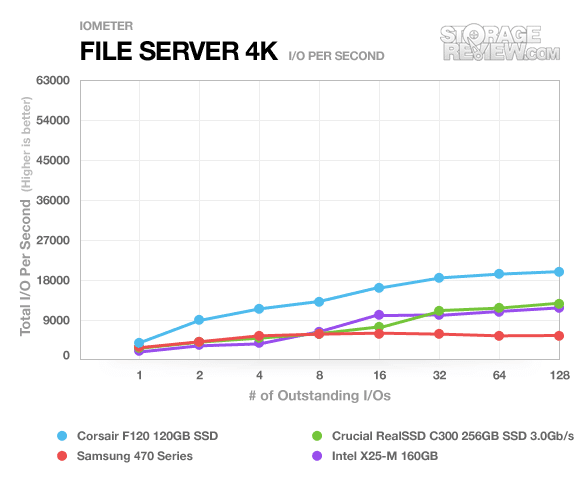
Using our server profile tests in IOMeter, we are able to accurately rank drives based on multithreaded use. Generally speaking this shows how well the NCQ support is of a given drive. In all of our tests except the Webserver profile (which is read-only) the Samsung SSD 470 seemed to fall flat quickly after two outstanding I/Os. In the workstation and database test this was overly apparent as the other drives pretty much blew it away in some cases.
Real-World Benchmarks
With the synthetics out of the way, we have a healthy understanding of how we can expect the Samsung 470 to perform in real life workloads. The expectation is that it’ll more or less fall in line with the others, although the odd peaks we’ve seen with random accesses may surface.
For all of our real-world benchmarks we use custom StorageMark 2010 traces and try to work the drives the way a regular user might in varying scenarios.
The first trace is the “HTPC” test, which includes playing one 720p HD movie in Media Player Classic, playing one 480p SD movie in VLC, downloading three movies simultaneously through iTunes, and recording one 1080i HDTV stream through Windows Media Center over a fifteen minute period.
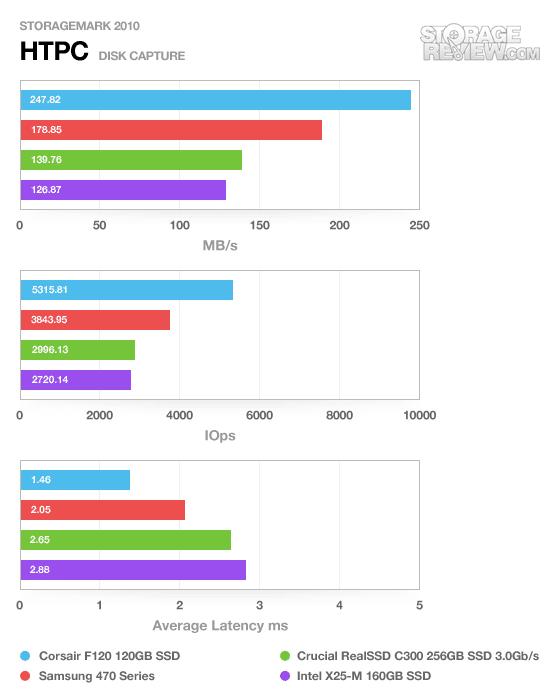
In the HTPC test the Samsung SSD 470 did very good up against what can be considered the best drives currently on the market. It had a healthy above the Crucial RealSSD C300 in SATA 3.0GBps mode and the Intel X25-M. Against the formidable Sandforce-based Corsair F120 it came in second, but still very impressive results.
The second trace is the “Productivity” test, which consists of: a three hour period operating with 32-bit Vista running Outlook 2007 and connected to an Exchange server, browsing the internet with both Google Chrome and Internet Explorer 8, editing files in Office 2007, viewing PDFs in Adobe Reader, an hour of local music playback, and then two additional hours of streaming online music from Pandora.
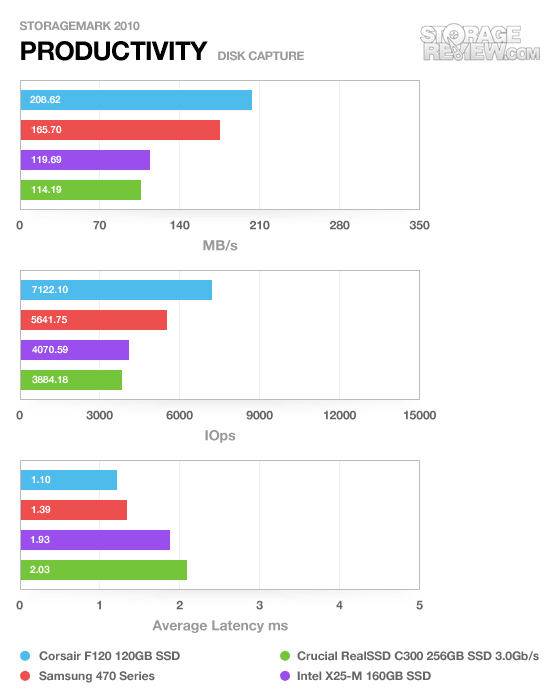
In the Productivity trace the Samsung SSD 470 stayed in the #2 position again, this time closing the gap slightly on the Corsair F120. It still maintained its impressive lead above the Intel and Crucial SSD.
The third and final trace is the “Gaming” test; this test is almost entirely read-based, and consists of Windows 7 Ultimate 64-bit configured with Steam, and traces performance loading and running Grand Theft Auto 4, Left 4 Dead 2, and Mass Effect 2.
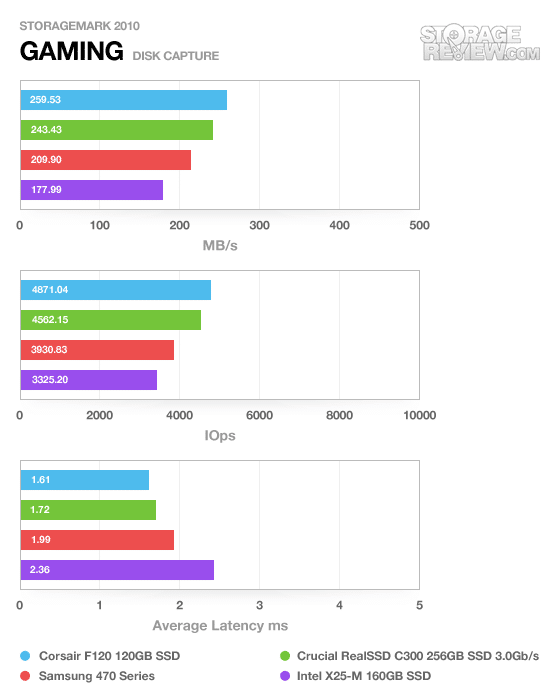
In the Gaming trace the Samsung SSD 470 slipped, with the Crucial RealSSD C300 pulling a slight lead over it, but it still stayed in front of the Intel X25-M.
Power Consumption
The 256GB Samsung SSD 470 claimed some pretty impressive power figures in its spec sheet, listing a 0.14W idle and 0.24W active measurement. Sadly we weren’t able to see figures that low across the board, but we did get pretty close on the idle figure.
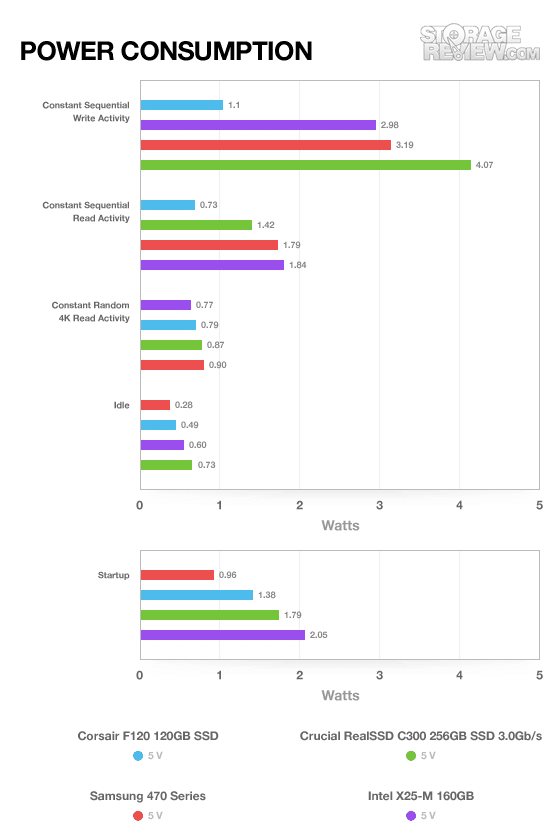
The Samsung SSD 470 led the group of four SSDs with its ultra-low 0.28W idle power consumption. With most drives spending most of their life sitting idle, the Samsung SSD will help squeeze a bit more battery life out of mobile systems. Startup power was also substantially lower than other competing models, coming in at 0.96W. Under standard operating conditions though, the SSD 470 ranked towards the upper end of the pack, with 3.19W write, 1.79W read, and 0.90W random read. Overall not to shabby, especially with that impressive idle figure.
Warranty
Samsung stays with the pack when it comes to warranty support, offering three years, which is the same as other manufacturers including Intel, Western Digital, Corsair, and Crucial. In terms of lifespan, Samsung claims a total lifetime figure of 21.9TB written, although that is the same for the 64, 128, and 256GB models. It would be safe to say real-world figures on the higher capacity models should be two or four times the 64GB version. They claim an average of 20GB written to the drive per day for three years to reach the 21.9TB figure.
Conclusion
The Samsung impressed us start to finish with the new 256GB SSD 470 Series retail kit. For their first introduction into the retail market they did an amazing job with the design of the SSD, down to the packaging that the drive is sold in. In a market where most drives come in a small black paper box, the clear acrylic case adds a touch of class, and really sets it off from day one.
In terms of performance the 256GB Samsung SSD 470 performed well against the upper tier of SSDs. When matched up with the 160GB Intel X25-M, the SandForce-based 120GB Corsair F120, and the 256GB Crucial RealSSD C300 the Samsung ranked middle to top of the pack in our tests. In our real-world benchmarks it came in second place in both the Productivity and HTPC tests, which we put most of our weight on.
Overall it did a great job for being a “newcomer” to the market, although Samsung did have some help being in the OEM market for a number of years now. Depending on how the prices look as the drive spends time on the market, the Samsung 470 Series SSD should be in high demand, and rightfully so.
Pros
- Speeds live up to its name
- Beats the X25-M and C300 in our Productivity and HTPC traces
- Super low idle and startup power figures
- Best looking packaging
Cons
- Weak NCQ results in our synthetic server profile tests
Bottom Line
For a newcomer to a performance-saturated market, Samsung did an excellent job creating the 470 Series SSD completely in house from controller to flash modules. In our real-world tests it came in 2nd place in HTPC and Productivity, beating out the Intel X25-M and Crucial RealSSD C300 in SATA 3.0 mode.
Discuss This Review




 Amazon
Amazon